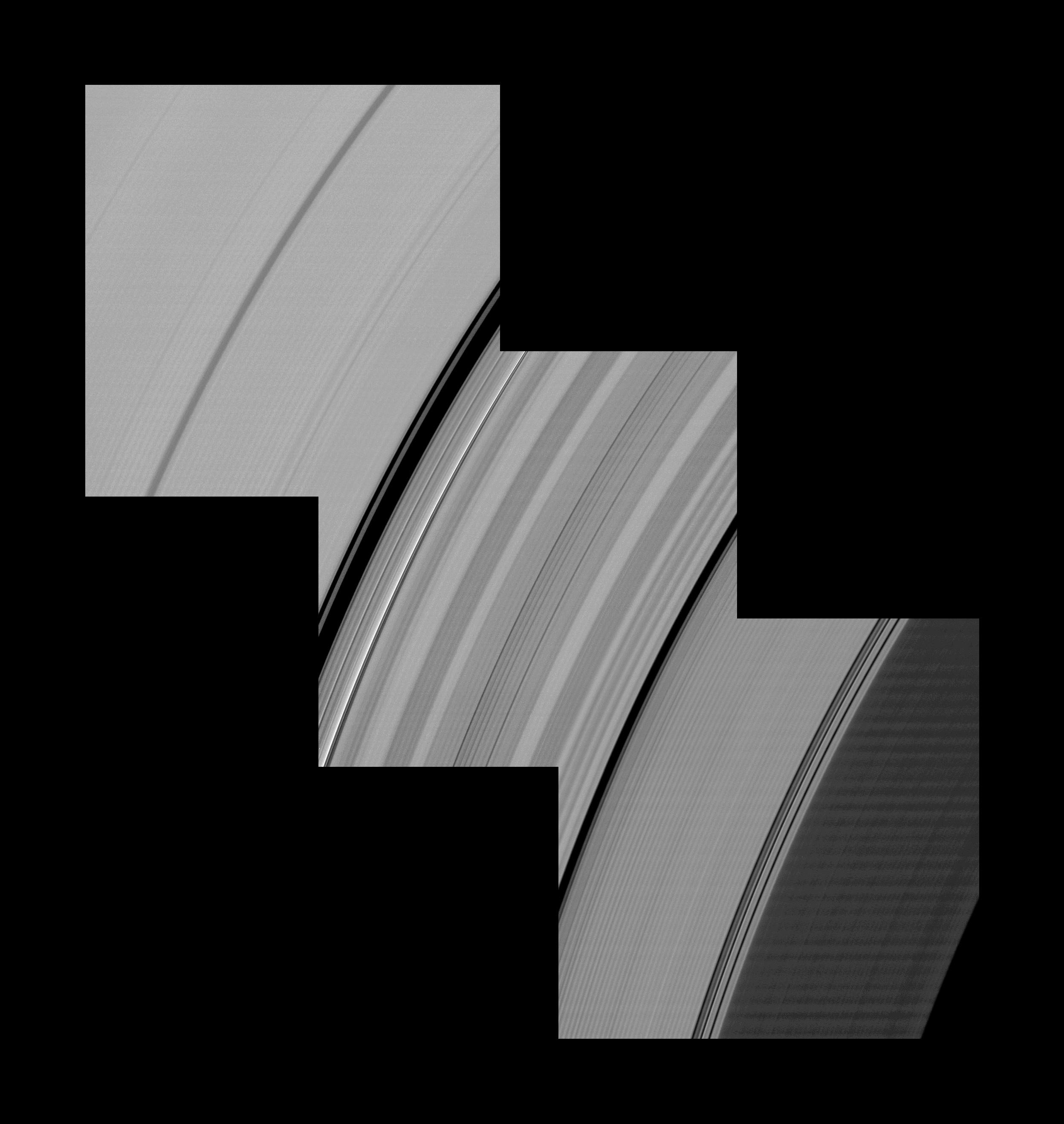Extensive Spiral Corrugations

| PIA Number | PIA11664 |
|---|---|
| Language |
|
Alternating light and dark bands, extending a great distance across Saturn's D and C rings, are shown here in these Cassini images taken one month before the planet's August 2009 equinox.
The C ring stretches across the upper left and middle of the mosaic image. The D ring is barely visible amid the noise in the lower right of the image.
The periodic brightness variations in the rings have a more subtle, narrow appearance in this mosaic of three Cassini images than other larger features of the rings, such as the Colombo Gap which appears as a black arc on the left of the center frame of the mosaic. These brightness variations are almost certainly caused by the changing slopes in the rippled ring plane, much like the corrugations of a tin roof. Although previous Cassini observations (see A Twisted Tail) had revealed corrugations in the D ring extending over 800 kilometers (500 miles), this image shows these features extending for 10,000 kilometers (6,200 miles) into the C ring.
Later equinox images revealed the true dimension of this corrugation, extending completely across the C ring, right up to the inner B ring edge for a total breath of about 19,000 kilometers (12,000 miles) -- see Ring Scan Spilling Secrets and Inner B Ring Terminus.
This and other new imagery support earlier evidence that something dramatic happened in the early 1980s to initiate this feature.
In 2006, imaging scientists speculated that a collision with a comet or asteroid may have disturbed the D ring. The C-ring and D-ring corrugations are part of the same phenomena, and were probably produced in the same event. For a graphic showing how the corrugation could have formed after a cloud of cometary debris struck and tilted the rings, see PIA12820.
Whatever caused the corrugation apparently tilted a vast region of the inner rings relative to Saturn's gravitational field in a relatively short period of time during the early 1980s. In the intervening years, the natural tendency for inclined orbits to systematically and slowly wobble at different rates, depending on their distance from Saturn, has created a tightly wound spiral corrugation in the ring plane.
These images and others like them are only possible around the time of Saturn's equinox, which occurs every half-Saturn-year (equivalent to about 15 Earth years). The illumination geometry that accompanies equinox lowers the sun's angle to the ringplane, significantly darkens the rings, and causes out-of-plane structures to cast long shadows across the rings. Cassini's cameras have spotted not only the predictable shadows of some of Saturn's moons (see Across Resplendent Rings), but also the shadows of newly revealed vertical structures in the rings themselves (see A Small Find Near Equinox).
This view looks toward the unilluminated side of the rings from about 24 degrees above the ringplane. The D ring has been brightened relative to C ring to enhance visibility.
The images were taken in visible light with the Cassini spacecraft narrow-angle camera on July 11, 2009. The view was acquired at a distance of approximately 470,000 kilometers (292,000 miles) from Saturn and at a Sun-Saturn-spacecraft, or phase, angle of 25 degrees. Image scale is 2 kilometers (about 1 mile) per pixel.
[Caption updated March 31, 2011.]
The Cassini-Huygens mission is a cooperative project of NASA, the European Space Agency and the Italian Space Agency. The Jet Propulsion Laboratory, a division of the California Institute of Technology in Pasadena, manages the mission for NASA's Science Mission Directorate, Washington, D.C. The Cassini orbiter and its two onboard cameras were designed, developed and assembled at JPL. The imaging operations center is based at the Space Science Institute in Boulder, Colo.
For more information about the Cassini-Huygens mission visit http://saturn.jpl.nasa.gov . The Cassini imaging team homepage is at http://ciclops.org .
Credit: NASA/JPL/Space Science Institute
